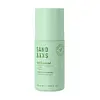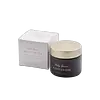What's inside
What's inside
 Key Ingredients
Key Ingredients

 Benefits
Benefits

 Concerns
Concerns

 Ingredients Side-by-side
Ingredients Side-by-side

Water
Skin ConditioningGlycerin
HumectantPropylheptyl Caprylate
EmollientSorbitan Stearate
EmulsifyingButylene Glycol
HumectantCaprylic/Capric Triglyceride
MaskingFomes Officinalis Extract
Skin ProtectingGlycol Palmitate
EmulsifyingNiacinamide
SmoothingSalicylic Acid
MaskingAloe Barbadensis Leaf Juice
Skin ConditioningSodium Starch Octenylsuccinate
AbsorbentPhenoxyethanol
PreservativeAmmonium Acryloyldimethyltaurate/Vp Copolymer
Inulin
Skin ConditioningCetearyl Alcohol
EmollientCellulose
AbsorbentPolyacrylate Crosspolymer-6
Emulsion StabilisingSodium Hydroxide
BufferingAlpha-Glucan Oligosaccharide
CleansingCetearyl Glucoside
EmulsifyingMaltodextrin
AbsorbentTocopherol
AntioxidantBixa Orellana Seed Extract
MaskingCentipeda Cunninghamii Extract
Skin ConditioningCitrus Australasica Fruit Extract
AntioxidantEthylhexylglycerin
Skin ConditioningTetrasodium Glutamate Diacetate
Helianthus Annuus Seed Oil
EmollientGlycol
HumectantTasmannia Lanceolata Fruit/Leaf Extract
AntioxidantHamamelis Virginiana Leaf Extract
Skin ConditioningPalmitic Acid
EmollientLaminaria Saccharina Extract
Skin ProtectingSodium Benzoate
MaskingCitric Acid
BufferingPEG-40 Hydrogenated Castor Oil
EmulsifyingPotassium Sorbate
PreservativeZinc Sulfate
AntimicrobialPyridoxine Hcl
Skin ConditioningWater, Glycerin, Propylheptyl Caprylate, Sorbitan Stearate, Butylene Glycol, Caprylic/Capric Triglyceride, Fomes Officinalis Extract, Glycol Palmitate, Niacinamide, Salicylic Acid, Aloe Barbadensis Leaf Juice, Sodium Starch Octenylsuccinate, Phenoxyethanol, Ammonium Acryloyldimethyltaurate/Vp Copolymer, Inulin, Cetearyl Alcohol, Cellulose, Polyacrylate Crosspolymer-6, Sodium Hydroxide, Alpha-Glucan Oligosaccharide, Cetearyl Glucoside, Maltodextrin, Tocopherol, Bixa Orellana Seed Extract, Centipeda Cunninghamii Extract, Citrus Australasica Fruit Extract, Ethylhexylglycerin, Tetrasodium Glutamate Diacetate, Helianthus Annuus Seed Oil, Glycol, Tasmannia Lanceolata Fruit/Leaf Extract, Hamamelis Virginiana Leaf Extract, Palmitic Acid, Laminaria Saccharina Extract, Sodium Benzoate, Citric Acid, PEG-40 Hydrogenated Castor Oil, Potassium Sorbate, Zinc Sulfate, Pyridoxine Hcl
Water
Skin ConditioningCaprylic/Capric Triglyceride
MaskingIsohexadecane
EmollientNiacinamide
SmoothingGlycerin
HumectantAloe Barbadensis Leaf Juice
Skin ConditioningButylene Glycol
HumectantCetearyl Olivate
Sorbitan Olivate
EmulsifyingDimethicone
EmollientCetearyl Alcohol
EmollientSqualane
EmollientPPG-12/Smdi Copolymer
EmollientTetrahexyldecyl Ascorbate
AntioxidantPhyllanthus Emblica Fruit Extract
HumectantCitrus Limon Fruit Extract
MaskingRuscus Aculeatus Root Extract
AstringentCalendula Officinalis Flower Extract
MaskingBrassica Oleracea Acephala Sprout Extract
AntioxidantGlycyrrhiza Glabra Root Extract
BleachingCucumis Sativus Fruit Extract
EmollientHamamelis Virginiana Extract
AntiseborrhoeicEnantia Chlorantha Bark Extract
Skin ConditioningCamellia Sinensis Leaf Extract
AntimicrobialOleanolic Acid
Skin ConditioningPhytic Acid
Retinyl Palmitate
Skin ConditioningTocopherol
AntioxidantHydroxyethyl Acrylate/Sodium Acryloyldimethyl Taurate Copolymer
Emulsion StabilisingPhenoxyethanol
PreservativeCaprylyl Glycol
EmollientAcrylates/C10-30 Alkyl Acrylate Crosspolymer
Emulsion StabilisingPolysorbate 60
EmulsifyingEthylhexylglycerin
Skin ConditioningHexylene Glycol
EmulsifyingSodium Hydroxide
BufferingParfum
MaskingDipotassium Glycyrrhizate
HumectantDisodium EDTA
Chlorophyllin-Copper Complex
AntioxidantWater, Caprylic/Capric Triglyceride, Isohexadecane, Niacinamide, Glycerin, Aloe Barbadensis Leaf Juice, Butylene Glycol, Cetearyl Olivate, Sorbitan Olivate, Dimethicone, Cetearyl Alcohol, Squalane, PPG-12/Smdi Copolymer, Tetrahexyldecyl Ascorbate, Phyllanthus Emblica Fruit Extract, Citrus Limon Fruit Extract, Ruscus Aculeatus Root Extract, Calendula Officinalis Flower Extract, Brassica Oleracea Acephala Sprout Extract, Glycyrrhiza Glabra Root Extract, Cucumis Sativus Fruit Extract, Hamamelis Virginiana Extract, Enantia Chlorantha Bark Extract, Camellia Sinensis Leaf Extract, Oleanolic Acid, Phytic Acid, Retinyl Palmitate, Tocopherol, Hydroxyethyl Acrylate/Sodium Acryloyldimethyl Taurate Copolymer, Phenoxyethanol, Caprylyl Glycol, Acrylates/C10-30 Alkyl Acrylate Crosspolymer, Polysorbate 60, Ethylhexylglycerin, Hexylene Glycol, Sodium Hydroxide, Parfum, Dipotassium Glycyrrhizate, Disodium EDTA, Chlorophyllin-Copper Complex
 Reviews
Reviews

Ingredients Explained
These ingredients are found in both products.
Ingredients higher up in an ingredient list are typically present in a larger amount.
Aloe Barbadensis Leaf Juice comes from leaves of the aloe plant. Aloe Barbadensis Leaf Juice is best known for helping to soothe sunburns. It is also anti-inflammatory, moisturizing, antiseptic, and can help heal wounds.
Aloe is packed with good stuff including Vitamins A, C, and E. These vitamins are antioxidants, which help fight free-radicals and the damage they may cause. Free-radicals are molecules that may damage your skin cells, such as pollution.
Aloe Barbadensis Leaf Juice also contains sugars. These sugars come in the form of monosaccharides and polysaccharides, folic acid, and choline. These sugars are able to help bind moisture to skin.
It also contains minerals such as calcium, 12 anthraquinones, fatty acids, amino acids, and Vitamin B12.
Learn more about Aloe Barbadensis Leaf JuiceButylene Glycol (or BG) is used within cosmetic products for a few different reasons:
Overall, Butylene Glycol is a safe and well-rounded ingredient that works well with other ingredients.
Though this ingredient works well with most skin types, some people with sensitive skin may experience a reaction such as allergic rashes, closed comedones, or itchiness.
Learn more about Butylene GlycolThis ingredient is an emollient, solvent, and texture enhancer. It is considered a skin-softener by helping the skin prevent moisture loss.
It helps thicken a product's formula and makes it easier to spread by dissolving clumping compounds.
Caprylic Triglyceride is made by combining glycerin with coconut oil, forming a clear liquid.
While there is an assumption Caprylic Triglyceride can clog pores due to it being derived from coconut oil, there is no research supporting this.
Learn more about Caprylic/Capric TriglycerideCetearyl alcohol is a mixture of two fatty alcohols: cetyl alcohol and stearyl alcohol. It is mainly used as an emulsifier. Emulsifiers help prevent the separation of oils and products. Due to its composition, it can also be used to thicken a product or help create foam.
Cetearyl alcohol is an emollient. Emollients help soothe and hydrate the skin by trapping moisture.
Studies show Cetearyl alcohol is non-toxic and non-irritating. The FDA allows products labeled "alcohol-free" to have fatty alcohols.
This ingredient is usually derived from plant oils such as palm, vegetable, or coconut oils. There is debate on whether this ingredient will cause acne.
Due to the fatty acid base, this ingredient may not be Malassezia folliculitis safe.
Learn more about Cetearyl AlcoholEthylhexylglycerin (we can't pronounce this either) is commonly used as a preservative and skin softener. It is derived from glyceryl.
You might see Ethylhexylglycerin often paired with other preservatives such as phenoxyethanol. Ethylhexylglycerin has been found to increase the effectiveness of these other preservatives.
Glycerin is already naturally found in your skin. It helps moisturize and protect your skin.
A study from 2016 found glycerin to be more effective as a humectant than AHAs and hyaluronic acid.
As a humectant, it helps the skin stay hydrated by pulling moisture to your skin. The low molecular weight of glycerin allows it to pull moisture into the deeper layers of your skin.
Hydrated skin improves your skin barrier; Your skin barrier helps protect against irritants and bacteria.
Glycerin has also been found to have antimicrobial and antiviral properties. Due to these properties, glycerin is often used in wound and burn treatments.
In cosmetics, glycerin is usually derived from plants such as soybean or palm. However, it can also be sourced from animals, such as tallow or animal fat.
This ingredient is organic, colorless, odorless, and non-toxic.
Glycerin is the name for this ingredient in American English. British English uses Glycerol/Glycerine.
Learn more about GlycerinNiacinamide is a multitasking form of vitamin B3 that strengthens the skin barrier, reduces pores and dark spots, regulates oil, and improves signs of aging.
And the best part? It's gentle and well-tolerated by most skin types, including sensitive and reactive skin.
You might have heard of "niacin flush", or the reddening of skin that causes itchiness. Niacinamide has not been found to cause this.
In very rare cases, some individuals may not be able to tolerate niacinamide at all or experience an allergic reaction to it.
If you are experiencing flaking, irritation, and dryness with this ingredient, be sure to double check all your products as this ingredient can be found in all categories of skincare.
When incorporating niacinamide into your routine, look out for concentration amounts. Typically, 5% niacinamide provides benefits such as fading dark spots. However, if you have sensitive skin, it is better to begin with a smaller concentration.
When you apply niacinamide to your skin, your body converts it into nicotinamide adenine dinucleotide (NAD). NAD is an essential coenzyme that is already found in your cells as "fuel" and powers countless biological processes.
In your skin, NAD helps repair cell damage, produce new healthy cells, support collagen production, strengthen the skin barrier, and fight environmental stressors (like UV and pollution).
Our natural NAD levels start to decline with age, leading to slower skin repair, visible aging, and a weaker skin barrier. By providing your skin niacinamide, you're recharging your skin's NAD levels. This leads to stronger, healthier, and younger looking skin.
Another name for vitamin B3 is nicotinamide. This vitamin is water-soluble and our bodies don't store it. We obtain Vitamin B3 from either food or skincare. Meat, fish, wheat, yeast, and leafy greens contain vitamin B3.
The type of niacinamide used in skincare is synthetically created.
Learn more about NiacinamidePhenoxyethanol is a preservative that has germicide, antimicrobial, and aromatic properties. Studies show that phenoxyethanol can prevent microbial growth. By itself, it has a scent that is similar to that of a rose.
It's often used in formulations along with Caprylyl Glycol to preserve the shelf life of products.
Sodium Hydroxide is also known as lye or caustic soda. It is used to adjust the pH of products; many ingredients require a specific pH to be effective.
In small amounts, sodium hydroxide is considered safe to use. However, large amounts may cause chemical burns due to its high alkaline.
Your skin has a natural pH and acid mantle. This acid mantle helps prevent harmful bacteria from breaking through. The acid mantle also helps keep your skin hydrated.
"Alkaline" refers to a high pH level. A low pH level would be considered acidic.
Learn more about Sodium HydroxideTocopherol (also known as Vitamin E) is a common antioxidant used to help protect the skin from free-radicals and strengthen the skin barrier. It's also fat soluble - this means our skin is great at absorbing it.
Vitamin E also helps keep your natural skin lipids healthy. Your lipid skin barrier naturally consists of lipids, ceramides, and fatty acids. Vitamin E offers extra protection for your skin’s lipid barrier, keeping your skin healthy and nourished.
Another benefit is a bit of UV protection. Vitamin E helps reduce the damage caused by UVB rays. (It should not replace your sunscreen). Combining it with Vitamin C can decrease sunburned cells and hyperpigmentation after UV exposure.
You might have noticed Vitamin E + C often paired together. This is because it is great at stabilizing Vitamin C. Using the two together helps increase the effectiveness of both ingredients.
There are often claims that Vitamin E can reduce/prevent scarring, but these claims haven't been confirmed by scientific research.
Learn more about TocopherolWater. It's the most common cosmetic ingredient of all. You'll usually see it at the top of ingredient lists, meaning that it makes up the largest part of the product.
So why is it so popular? Water most often acts as a solvent - this means that it helps dissolve other ingredients into the formulation.
You'll also recognize water as that liquid we all need to stay alive. If you see this, drink a glass of water. Stay hydrated!
Learn more about Water